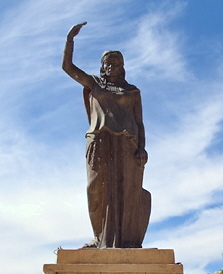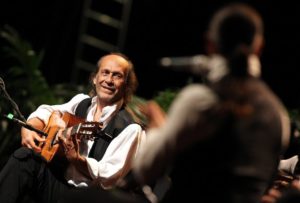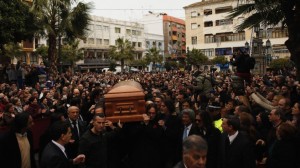The Passing of Paco de Lucia, Flamenco… and the Expulsion of the Jews
Last month, one of the giants of guitar, Paco de Lucia, passed away tragically. His untimely death was the result of a heart attack at age 66 while playing with his children on a beach in Mexico. Spain went into national mourning, as did millions of music lovers around the world. De Lucia was instrumental in mainstreaming flamenco. He also crossed over into jazz and classical music. If you haven’t heard his legendary concert with John McLaughlin and Al di Meola (San Francisco, 1981), I envy your first time experience.
j
De Lucia was born in 1947 in southern Spain. According to official histories, southern Spain was first colonized in the 8/9th century BCE by “Phoenicians”. But who were these “Phoenicians”? The fact is that there was never a people that called themselves “Phoenicians”. “Phoenicians” was what the ancient Greeks called the people living along the Israel-Lebanon coast. In other words, the people that Greeks called “Phoenicians” were a basket of two peoples that included ancient Canaanites and Israelites. So when scholars say that southern Spain was first colonized by “Phoenicians”, what they’re really saying is that southern Spain was first colonized by Canaanites and Israelites. Perhaps it is no coincidence that Spain and Portugal are on a peninsula named by these earliest peoples; the “Hebrew Peninsula” or, as it’s more commonly known, the “Iberian Peninsula” from the Hebrew “Ivri”, meaning Hebrew. (Of course many scholars will tell you that “Ivri” in this instance does not refer to the “Ivriim” i.e., the Hebrews, but simply to the Semitic word for “crossing over”).
Getting back to Paco, the point is that he was born in a place that has a very, very ancient connection to Israelites. In fact, to this day, people in Cadiz – the province that Paco was born in – don’t call themselves “Cadizians”, but “Gaditanos” i.e., Gadites. Of course, the “Gadites” were one of the so-called “Lost Tribes of Israel”, and it may very well be that part of the so-called ancient “Pheonicians” who colonized the area of Cadiz were Israelites from the tribe of Gad.
Turning to more modern history, and I use “modern” in a Jewish sense i.e., I’m talking about very ancient events, the “Moors” conquered southern Spain in 711 CE/AD. The Moors were Muslim and they came from the area of Northwest Africa. Usually they are described as “Arabs”, but they were really a combination of Arabs and Berbers, a tribe that you still find in modern Tunisia, Algeria and Morocco. And here’s a surprise – before the Muslim-Arab conquest of Tunisia, the Berbers were Jews. In fact, many Moroccan Jews in Israel today can trace their origins to the Judaized Berbers.

The most famous Jewish Berber was La Kahina. She was a Berber queen who likely had some “Cohen” i.e., Jewish priestly, ancestry in her lineage. According to the great Arab historian of the 15th century, Ibn Khaldun, she inflicted on the Arabs the only defeat suffered by the Muslim armies led by General Hassan Ibn Numan. After she was betrayed, General Hassan ultimately defeated her. Realizing that the end was near, La Kahina allowed her sons to go over to the enemy – since they worshipped the one God – but chose suicide rather than defeat for herself. Her son, Tarif, is credited with leading the armies that conquered Spain for Islam. Gibraltar is named after him. It is an Anglicization of the Arabic “Jabel El Tarif” i.e., the rock of Tarif. Put differently, since his mother was Jewish, Gibraltar is named after a nice Jewish boy.
In 1491, the power struggle between Muslims and Christians in Spain was decided in favor of the Christians. The Muslims either converted to Catholicism or retreated back to Africa. The Jews were given a choice – convert or leave. Half left, half could not so they converted. Many continued to live secret Jewish lives as “conversos”, or what scholars call: “crypto Jews”. Many stayed in Spain, but were driven to the periphery e.g., mountainous areas, where they lived in outlawed villages with Arabs, gypsies and Christians opposed to the mainstream Catholic Church. It is in these villages that Flamenco was born as the music of marginalized and outlawed peoples. If these renegades were caught, they were tortured and burned at the stake by the “Holy Inquisition” of the Catholic Church. Much like Jazz, Blues and Gospel music (which was in large part inspired by the Hebrew Bible) in the United States – flamenco is the music of the oppressed.

It seems that Paco de Lucia was descendant from Conversos on both sides of his family. His father’s name, “Sanchez”, was a common Converso name. His mother, Lucia, was Portuguese. Of those Jews who were expelled from Spain in 1492, many fled into nearby Portugal, where they were forcibly converted in 1497. “Gomez” was a common Converso name in Portugal and Paco’s mother’s maiden name was Gomez. To honor her, he took on “de Lucia” as his stage name. As the ultimate master of his craft, Paco was proud of flamenco’s origins and of their Jewish Spanish connection.
Paco knew that, in large part, flamenco was born of the oppression of the Jews. In the face of the rising tide of worldwide anti-Semitism, despite many efforts to get him to boycott the state of Israel, he refused to cooperate with the boycotts choosing instead to give one of his last concerts in the Jewish state (May 27th, 2013 in Ashdod). Long live Paco’s music.

See also my latest blog in the Times of Israel – The Greatest Bank Heist in Communist History!

